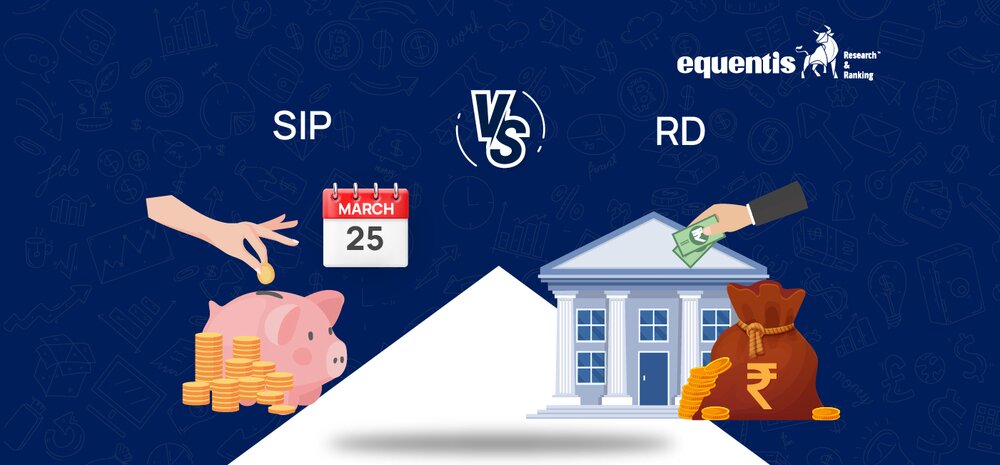Introduction
Understanding the Basics of SIP and Recurring Deposit
What is the first advice you often get when you plan to invest? Start small and stay consistent with saving a small portion every month. There are multiple strategies to match this disciplined style of investment, two of the common ones being SIP (Systematic Investment Plan) and RD (Recurring Deposits). Both options allow you to invest regularly, but their structures, risk levels, and return potentials differ significantly.
Why Comparing SIP vs RD is Important for Investors
Choosing between SIP and RD is essential for your financial planning, as each serves different investment objectives. While SIPs offer market-linked returns, RDs provide fixed interest. So which one to choose? Let’s understand what is SIP investment and RDs in detail to help you make informed decisions that align with your financial goals.
What is SIP (Systematic Investment Plan)?
Definition and How SIP Works
SIP is a method of investing in mutual funds where a fixed amount is invested at regular intervals. This investment strategy reduces risks associated with market fluctuations through rupee cost averaging. SIP auto-debits a fixed amount to buy mutual fund units at the prevailing Net Asset Value (per-unit value of a mutual fund). More units are bought when markets are low and fewer when high. This averaging effect helps mitigate the impact of market volatility, making SIPs a disciplined approach to investing.
Types of SIPs: Equity SIP, Debt SIP, and Hybrid SIP
- Regular SIP: You invest a fixed amount at regular intervals, purchasing mutual fund units based on the NAV of that day. This approach helps in disciplined investing without requiring active monitoring.
- Flexible SIP: Here, you can modify your investment amount or skip a contribution based on your financial situation. This flexibility allows you to adjust your investment strategy as needed.
- Perpetual SIP: Unlike fixed-tenure SIPs, this type continues indefinitely until you decide to stop it. It allows for uninterrupted wealth accumulation without the need for renewals.
- Trigger SIP: Your investment is executed based on predefined triggers such as specific market movements, NAV levels, or index fluctuations. This SIP helps investors capitalize on the market movements.
- Multi SIP: This allows you to invest in multiple mutual fund schemes through a single SIP transaction. So, instead of setting up separate SIPs for different mutual funds, you allocate your investment amount across various schemes of the same fund house.
- Step-up SIP: Allows you to increase the SIP contribution at predefined intervals, aligning investments with income growth and financial goals.
Why SIP is a Preferred Investment Option for Market-Linked Growth
SIPs enable systematic participation in equity and debt markets, reducing market timing risks. They offer the potential for inflation-adjusted growth over time due to compounding. Plus, they provide flexibility in investment amounts and withdrawal options, making them suitable for new and experienced investors.
What is RD (Recurring Deposit)?
Definition and How Recurring Deposits Work
A Recurring Deposit (RD) is a fixed-income investment where you regularly deposit a predetermined amount in a bank or post office. The deposit earns a fixed interest rate and gives stable returns throughout the tenure. RDs are thus ideal for investors seeking a disciplined savings approach that offers guaranteed returns without market risk.
Types of RDs: Bank RD vs Post Office RD
- Regular Recurring Deposits: These are the most common RD schemes where a fixed amount is deposited monthly for a specified tenure. The interest rate and deposit amount remain constant throughout the term.
- Recurring Deposits for Senior Citizens: Designed specifically for senior citizens, these RDs offer higher interest rates and additional benefits to support retirement savings.
- Flexi Recurring Deposits: Some banks offer Flexi RDs, allowing investors to deposit varying monthly amounts. This type suits individuals with irregular income patterns who want the flexibility to save more when possible.
- NRI Recurring Deposits: These RDs are tailored for Non-Resident Indians (NRIs) and offer competitive interest rates and remote account management facilities.
- Special Recurring Deposits: Some banks provide RD schemes targeted at specific customer segments, such as women or children, with enhanced benefits and interest rates to encourage savings.
Why RDs Are Considered Safe and Stable Investment Options
Unlike market-linked investments, RDs are unaffected by market volatility, making them a low-risk choice for wealth accumulation. Since they are offered by banks and post offices regulated by the RBI or the government, they provide a high level of security. The fixed tenure and structured savings approach also encourage disciplined financial habits while safeguarding the principal amount. The guaranteed interest rate makes them suitable for conservative financial planning for those prioritizing security over high returns.
Difference Between SIP and Recurring Deposit
Returns: SIP vs RD Returns Comparison
SIP returns depend on market performance, potentially offering higher long-term gains, whereas RD returns are predetermined based on fixed interest rates.
Risk Factor: Market-Linked vs Fixed Returns
SIPs carry market risks, making them volatile in the short term, while RDs are risk-free investments with assured returns.
Investment Tenure and Liquidity Differences
SIPs offer flexible investment tenure and liquidity, allowing you to withdraw funds partially or fully. RDs have fixed tenures with penalties for premature withdrawals.
Taxation: SIP vs RD Tax Benefits
SIP earnings are classified as capital gains, with tax rates depending on the holding period. Equity-linked SIPs like ELSS offer tax deductions of up to Rs.1.5 lakh under Section 80C. On the other hand, RD interest is fully taxable, added to your income, and taxed as per your applicable slab rate.
Interest Rate Differences: SIP vs RD Interest Rate Comparison
SIP returns vary with market conditions, whereas RD interest rates are predetermined and stable.
| Parameter | SIP (Systematic Investment Plan) | RD (Recurring Deposit) |
| Returns | Market-linked returns | Fixed returns at a predetermined interest rate |
| Risk | Subject to market fluctuations and volatility | Risk-free, as returns are not influenced by market volatility. |
| Liquidity | High liquidity allows partial or complete withdrawals, though exit loads or capital gains tax may apply. | Limited liquidity; premature withdrawals may attract penalties and lower interest earnings. |
| Taxation | Gains are taxed as per the holding period. Tax benefits under section 80C are available for ELSS SIPs. | Interest earned is fully taxable as per your income slab. No tax benefits are available. |
| Investment Tenure | Flexible | Fixed tenure chosen at the time of account opening. |
| Inflation Impact | Can beat inflation over time due to market-linked returns. | Fixed interest rates may not always outpace inflation, leading to lower actual returns. |
SIP or RD: Which is Better for Different Investors?
SIP vs RD for Short-Term Investment Goals
RDs are better suited for your short-term goals due to their stable returns, whereas SIPs may experience fluctuations in the short run.
SIP vs RD for Long-Term Wealth Creation
SIPs have the potential to generate wealth over the long term through compounding and market appreciation, making them preferable for long-term investment goals. However, you can also take the help of a share advisory company to make the most suitable investment decision.
Who Should Invest in SIP and Who Should Choose RD?
SIP Investors
SIPs are suitable if you are open to market-linked investments and willing to take some risk for higher potential returns. With options across equity, debt, and hybrid funds, SIPs cater to different risk appetites. They also offer flexibility, compounding benefits, and tax-saving options like ELSS.
RD Investors
RDs are ideal if you prefer guaranteed returns and a risk-free savings approach. They ensure stable earnings with fixed interest rates and no market dependency, making them a good choice for conservative investors.
Choosing between SIP and RD depends on your risk tolerance, financial goals, and investment horizon. RD or SIP calculators can help estimate returns while consulting a financial advisor can provide further clarity.
Benefits and Drawbacks of SIP and RD
Advantages of Investing in SIPs
- Potential for higher long-term returns.
- Rupee cost averaging minimizes the impact of market fluctuations.
- Flexible investment tenure and withdrawal options.
Disadvantages of SIP: When It May Not Be Suitable
- Subject to market risks and volatility.
- Returns are not guaranteed.
- Requires a longer investment horizon for optimal benefits.
Benefits and Drawbacks of RD
Advantages of Investing in RDs
- Assured and fixed returns.
- Low-risk investment option.
- Suitable for disciplined savings.
Disadvantages of RD: When It May Not Be the Best Option
- Returns are lower compared to market-linked investments.
- Interest earnings are taxable.
- Premature withdrawals may incur penalties.
How to Decide Between SIP and RD?
- Understanding Your Financial Goals and Risk Appetite
You should assess your risk tolerance and investment objectives before choosing between SIP and RD.
- Evaluating Tax Implications and Return Potential
Taxation plays a significant role in net returns. While SIPs may offer tax-efficient gains, RDs attract tax on the entire interest earned.
- Choosing the Right Investment Based on Market Conditions
Market conditions influence SIP returns, whereas RD returns remain unaffected. You should consider economic trends before making a decision.
Real-World Examples of SIP vs RD Investments
- Case Study: A Long-Term SIP Investment in Mutual Funds
Suppose you wish to save for retirement and choose SIP for its market-linked potential returns. You start with an initial investment of Rs.5,000 and contribute Rs.3,000 monthly into an equity mutual fund. Assuming an average annual return of 12%, your investment grows significantly over time.
- After 10 years, your total investment of Rs.3.65 lakh could grow to approximately Rs.7.9 lakh.
- After 20 years, your total investment of Rs.7.25 lakh could reach around Rs.25.2 lakh.
- After 30 years, your total investment of Rs.10.85 lakh may accumulate to nearly Rs.88 lakh, thanks to compounding and market appreciation.
- Case Study: How an RD Helped a Conservative Investor
Suppose you plan to save for an international vacation in two years and opt for a Recurring Deposit for its fixed returns. By depositing Rs.8,000 monthly at an interest rate of 6.5% per annum, your savings grow predictably. At the end of 24 months, your total deposits of Rs.1.92 lakh will earn approximately Rs.13,500 in interest, giving you a maturity amount of Rs.2.05 lakh.
Conclusion
Key Takeaways on SIP vs. RD Investment Choice
SIP and RD cater to different investor needs. While SIPs offer higher potential returns with risks, RDs ensure stability with fixed earnings.
How to Align Your Investment Strategy with Financial Goals
Start by setting clear, time-bound financial goals and assess your risk tolerance for each goal. External factors like inflation can significantly affect future costs. Then, choose the right investment approach (SIPs, RDs, or SIFs) based on your goal’s timeline and current market conditions. Lastly, review your portfolio regularly to track progress and adjust as needed.
Related Posts
Disclaimer Note: The securities quoted, if any, are for illustration only and are not recommendatory. This article is for education purposes only and shall not be considered as a recommendation or investment advice by Equentis – Research & Ranking. We will not be liable for any losses that may occur. Investments in the securities market are subject to market risks. Read all the related documents carefully before investing. Registration granted by SEBI, membership of BASL & the certification from NISM in no way guarantee the performance of the intermediary or provide any assurance of returns to investors.
FAQ
What are SIFs?
Systematic Investment Funds are a disciplined way to invest in mutual funds regularly, helping build wealth over time through fixed, periodic investments.
Does inflation affect RD returns?
Inflation can affect RD (Recurring Deposit) returns by reducing the purchasing power of the interest earned. While RD offers fixed returns, inflation can erode the actual value of those returns over time, making them less effective in meeting long-term financial goals.
Can I withdraw RD before maturity?
Yes, you can withdraw an RD (Recurring Deposit) before maturity, but doing so typically comes with a penalty.
How useful was this post?
Click on a star to rate it!
Average rating 0 / 5. Vote count: 0
No votes so far! Be the first to rate this post.
waitfor delay '0:0:5'--
I’m Archana R. Chettiar, an experienced content creator with
an affinity for writing on personal finance and other financial content. I
love to write on equity investing, retirement, managing money, and more.
 Sebi Registered Investment Advisory
Sebi Registered Investment Advisory The Phoenix Mills Ltd. (PDF)
The Phoenix Mills Ltd. (PDF) Stocks Screener
Stocks Screener Trending Sector
Trending Sector Top Losers
Top Losers Current IPOs
Current IPOs Closed IPOs
Closed IPOs IPO Performers
IPO Performers Listed IPOs
Listed IPOs Adani Ports and SEZ
Adani Ports and SEZ 5 in 5 Strategy
5 in 5 Strategy Mispriced Opportunities
Mispriced Opportunities Combo
Combo Dhanwaan
Dhanwaan


















